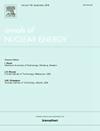A boron concentration maneuvering control algorithm for reactivity management during transients in VVER-1000 nuclear power units
IF 1.9
3区 工程技术
Q1 NUCLEAR SCIENCE & TECHNOLOGY
引用次数: 0
Abstract
Effective reactivity management is paramount for the safe and efficient operation of VVER-1000 reactors. A high-fidelity dynamic model is developed for boron control based on point kinetic equations, which capture the complex reactor kinetics, boron dynamics, and associated feedback systems governing the reactor’s behavior. The algorithm utilized a Proportional–Integral–Derivative controller optimized via Sequential Quadratic Programming (PID-SQP controller) to optimize boron maneuvering and compensate for external disturbances successfully. Step disturbances are applied to reactor inlet temperature at different boration/dilution rates to assess the algorithm’s resilience. The controller successfully regulated the power but exhibited different characteristics regarding overshoot, undershoot, smoothness of the change, and settling time. A statistical-based optimization analysis of the responses is conducted to determine the optimal levels for smooth and fast responses. The results exhibit enhanced stability, faster response times, and reduced boron overshoot transients. A dynamic optimization plot is constructed to figure out the boration/dilution rate yielding the highest composite desirability index.
求助全文
约1分钟内获得全文
求助全文
来源期刊

Annals of Nuclear Energy
工程技术-核科学技术
CiteScore
4.30
自引率
21.10%
发文量
632
审稿时长
7.3 months
期刊介绍:
Annals of Nuclear Energy provides an international medium for the communication of original research, ideas and developments in all areas of the field of nuclear energy science and technology. Its scope embraces nuclear fuel reserves, fuel cycles and cost, materials, processing, system and component technology (fission only), design and optimization, direct conversion of nuclear energy sources, environmental control, reactor physics, heat transfer and fluid dynamics, structural analysis, fuel management, future developments, nuclear fuel and safety, nuclear aerosol, neutron physics, computer technology (both software and hardware), risk assessment, radioactive waste disposal and reactor thermal hydraulics. Papers submitted to Annals need to demonstrate a clear link to nuclear power generation/nuclear engineering. Papers which deal with pure nuclear physics, pure health physics, imaging, or attenuation and shielding properties of concretes and various geological materials are not within the scope of the journal. Also, papers that deal with policy or economics are not within the scope of the journal.
 求助内容:
求助内容: 应助结果提醒方式:
应助结果提醒方式:


